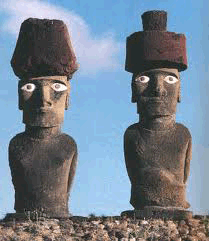
It is a cautionary tale, full of form and fury, signifying everything.
In roughly 400 A.D., a group of sea-faring Polynesians arrived on a remote island. Unfortunately,
due to the drift of the tides,
they were unable to leave. But they had found a lush tropical home, and at first they thrived.
On Earth, the tiger population has fallen 95% in the past century.
They called themselves the Rapa Nui, and found themselves 1100 miles from the nearest island.
There were 65,000 black rhinos in 1970. There are 3100 now.
Their population grew to nearly 11,000. They carved inscrutable statues, with deep eye sockets. The statues weighed almost 90 tons. Hats weighing two to four tons sat atop the statues without being
attached. The statues sat in a ring along the coastline, facing inward away from the sea.
Between 1970 and 2000 Earth's tree sparrow population has dropped 90%.
In the sixteenth century they stopped making statues. In fact, they disappeared entirely.
The North Atlantic cod have dropped from 264,000 tons in 1970 to less than 60,000 in 1995.
Originally there were two distinct groups of Rapa Nui, the long-eared people who became the rulers,
and the short-eared who were the workers. Eventually the short-eared ate the long-eared. Maybe they brought voracious rats with them and were overtaken by the rats. More likely they consumed all of the
resources of the island, overgrazing the tough grass, exterminating forests. When they had nothing left
to eat they ate each other.

We call them the Easter Islanders. What will tomorrow's civilization call us?
The World Wildlife Federation says that at the current rate the earth will run out of resources by 2050.
The seas will have no fish.
The forests will be wiped out.
Fresh water supplies will be exhausted.
The Rapa Nui were the first civilization to consume itself into extinction. Are we the next?
c. Corinne Whitaker 2012
Note: The San Francisco Chronicle has published this review of a once-lovely lake and its current pathetic state. I'm sure there are many such stories in your own area.